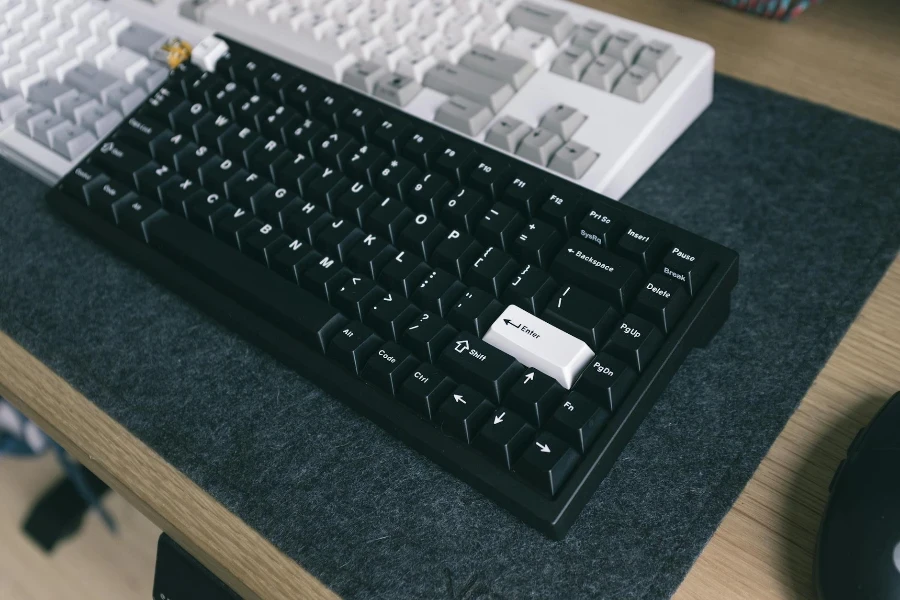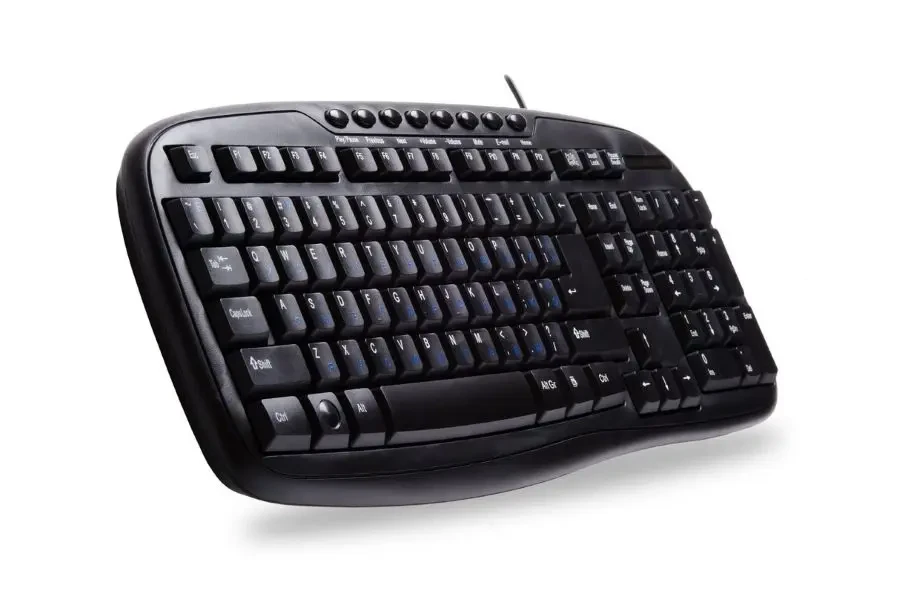As the demand for ergonomic office solutions continues to rise, staying updated on the latest trends and innovations is crucial. This article provides an in-depth analysis of the ergonomic keyboard market, detailing key considerations for professional buyers. By understanding these factors, businesses can make informed decisions, ensuring they stock the best ergonomic keyboards to meet growing consumer needs.
Table of Contents:
– Market Overview of Ergonomic Keyboards
– Detailed Introduction and Analysis of the Ergonomic Keyboard Market
– Key Factors When Selecting an Ergonomic Keyboard
– Ergonomic Benefits and Health Considerations
– Technological Advancements in Ergonomic Keyboards
– Market Trends and Future Prospects
– Wrapping Up the Essentials
Market Overview of Ergonomic Keyboards

The global ergonomic computer equipment market, which includes ergonomic keyboards, is projected to grow significantly. The market is forecasted to grow by USD 1.07 billion from 2023 to 2028, with a compound annual growth rate (CAGR) of 5.86%. This growth is driven by an increased employer focus on creating a healthy work environment, the rising use of PCs for gaming, and the expansion of the corporate sector. Additionally, the ergonomic computer equipment market, estimated at USD 3.2 billion in 2023, is projected to reach USD 4.2 billion by 2030, growing at a CAGR of 4.1%.
North America was the largest region in the keyboard market in 2023 and is expected to remain dominant. The U.S. market alone was estimated at USD 859.1 million in 2023. The Asia-Pacific region, with a robust manufacturing base and a large consumer market, is also anticipated to maintain its dominance. This region’s market is forecasted to grow at an impressive CAGR of 7.8%, reaching USD 894.2 million by 2030.
The market segmentation includes various types of ergonomic computer equipment, such as ergonomic desks, chairs, and keyboards. The ergonomic keyboard segment is expected to grow at a CAGR of 4.0% over the analysis period. The primary distribution channels for these products are online and offline stores, catering to corporate, personal, and gaming applications.
Detailed Introduction and Analysis of the Ergonomic Keyboard Market

The ergonomic keyboard market is characterized by several key performance benchmarks and market share dynamics. The market’s growth is significantly influenced by the increasing prevalence of remote work, which has heightened the need for ergonomic solutions that enhance comfort and productivity. As more individuals set up home offices, the demand for ergonomic keyboards, which reduce strain and promote better posture, has surged.
Consumer behavior has shifted towards a preference for customizable and durable ergonomic keyboards. Recent innovations include the integration of smart technology into ergonomic keyboards, such as smart desks and chairs that monitor posture and provide feedback to users. This trend highlights a broader move towards digitalization and the incorporation of advanced features in ergonomic equipment.
Technological advancements have led to shorter product life cycles for ergonomic keyboards. Manufacturers are focusing on developing keyboards with eco-friendly materials and sustainable design practices, responding to increasing environmental regulations and consumer demand for green products. Additionally, the rise in awareness of workplace health and wellness has driven companies to invest in ergonomic keyboards as part of their employee wellness programs.
Customer pain points primarily revolve around the high cost of quality ergonomic products and the lack of standardization in the market. To address these issues, manufacturers are developing more affordable ergonomic keyboards and providing clear information about their health benefits. The competitive landscape includes major players such as Logitech International SA, Microsoft Corporation, and Dell Technologies Inc., who are focusing on differentiation strategies through technological innovation and customization options.
The ergonomic keyboard market is poised for steady growth driven by technological advancements, increasing awareness of health and wellness, and the rising demand for ergonomic solutions in both corporate and home office settings.
Key Factors When Selecting an Ergonomic Keyboard

Choosing the right ergonomic keyboard involves understanding various factors that can significantly impact comfort, productivity, and overall experience. Here, we delve into the critical aspects to consider when selecting an ergonomic keyboard.
Design and Layout
The design and layout of an ergonomic keyboard are essential for ensuring comfort and reducing strain. Ergonomic keyboards often feature split designs, allowing for a more natural hand position. This design minimizes wrist bending, reducing the risk of repetitive strain injuries (RSIs). Models like the Microsoft Sculpt Ergonomic Keyboard offer a split keyset and a cushioned palm rest for enhanced comfort during prolonged use.
Additionally, key layout can vary. Some ergonomic keyboards have a contoured shape to follow the natural curve of your hands, reducing the stretch required to reach certain keys. Key placement is also crucial; keys should be positioned to minimize unnecessary finger movements, promoting a more efficient typing experience.
Build Quality and Materials
The build quality and materials used in an ergonomic keyboard are critical for durability and user comfort. High-quality materials, such as aircraft-grade aluminum or durable plastics, ensure the keyboard can withstand extensive use without degrading. For instance, the Logitech G915 TKL uses an aluminum alloy body, providing robustness and a premium feel.
The type of key switches used also affects durability and typing experience. Mechanical switches are popular for their longevity and tactile feedback. The K552 Kumara features Cherry MX Blue equivalent switches, offering a satisfying tactile response and durability.
Adjustability and Customization
An ergonomic keyboard should offer various adjustability options to cater to different user preferences and ergonomic needs. Adjustable tilt mechanisms allow users to set the keyboard at a comfortable angle, reducing wrist strain. Some keyboards also provide adjustable split angles, enabling users to customize the extent of the split.
Customization features, such as programmable keys and customizable backlighting, can enhance the user experience. Programmable keys allow users to assign specific functions or macros, improving productivity. Customizable backlighting adds aesthetic appeal and aids visibility in low-light conditions, as seen in keyboards like the K552 Kumara.
Compatibility and Connectivity
Compatibility with various devices and operating systems is crucial when selecting an ergonomic keyboard. Modern ergonomic keyboards often come with multiple connectivity options, including wired, Bluetooth, and wireless RF. The Logitech K380, for example, is a multi-device Bluetooth keyboard compatible with Windows, macOS, Chrome OS, Android, and iOS.
Connectivity options should be reliable and offer seamless switching between devices. Bluetooth connectivity is beneficial for users who need to switch between multiple devices, such as a laptop, tablet, and smartphone. USB-C connectivity is becoming increasingly common, providing faster data transfer rates and a more stable connection.
Price and Warranty
The price range of ergonomic keyboards can vary significantly, from budget-friendly models to high-end options. Consider your budget and the features you need. Budget models, such as the K552 Kumara, offer excellent value with essential ergonomic features, while premium models like the Logitech G915 TKL provide advanced features and superior build quality.
Warranty and customer support are also vital considerations. A good warranty ensures coverage in case of defects or issues with the keyboard. Most reputable brands offer at least a one-year warranty, with some extending up to three years. Excellent customer support provides peace of mind, knowing that any problems will be promptly addressed.
Ergonomic Benefits and Health Considerations

Using an ergonomic keyboard can have significant health benefits, particularly for individuals who spend long hours typing. Ergonomic keyboards are designed to reduce strain on your hands, wrists, and arms, potentially preventing conditions such as carpal tunnel syndrome and other repetitive strain injuries.
Reduction of Strain and Fatigue
Ergonomic keyboards are designed to minimize strain and fatigue. The split design allows for a more natural hand position, reducing wrist bending. This design helps distribute typing force more evenly across your hands and fingers, decreasing the likelihood of strain and fatigue.
A cushioned palm rest, as seen in the Microsoft Sculpt Ergonomic Keyboard, provides additional wrist support, further reducing strain. By promoting a more relaxed typing posture, ergonomic keyboards can help prevent musculoskeletal disorders.
Prevention of Repetitive Strain Injuries (RSIs)
RSIs are common among individuals who engage in repetitive tasks, such as typing. Ergonomic keyboards mitigate the risk of RSIs by promoting a more natural typing posture. The contoured shape and split design help align your wrists and hands in a neutral position, reducing strain on tendons and muscles.
Keyboards with adjustable tilt mechanisms allow users to customize the angle to suit their ergonomic needs, further reducing the risk of RSIs by ensuring the keyboard is positioned optimally for typing.
Enhanced Comfort for Prolonged Use
For those who spend long hours typing, comfort is critical. Ergonomic keyboards are designed with comfort in mind, offering features such as cushioned palm rests, contoured key shapes, and adjustable tilt mechanisms. These features work together to create a more comfortable typing experience, reducing the likelihood of discomfort and fatigue.
The tactile feedback from mechanical switches, like those in the K552 Kumara, also enhances comfort by providing a satisfying typing experience. This feedback reduces the force required to press each key, further minimizing strain on your fingers and hands.
Technological Advancements in Ergonomic Keyboards

The ergonomic keyboard market has seen significant technological advancements, enhancing functionality and user experience. From advanced key switches to wireless connectivity, these innovations have made ergonomic keyboards more versatile and user-friendly.
Advanced Key Switches
One notable advancement is the development of advanced key switches. Mechanical switches, such as Cherry MX and their equivalents, offer superior tactile feedback and durability compared to traditional membrane switches. These switches provide a consistent typing experience, with each keypress registering accurately and reliably.
Some ergonomic keyboards feature low-profile switches, reducing the travel distance of each keypress. This design helps reduce strain on your fingers and hands, making typing more comfortable and efficient. The Logitech G915 TKL, for example, uses low-profile GL switches, offering a speedy and responsive typing experience.
Wireless Connectivity and Multi-Device Pairing
Wireless connectivity has become a standard feature in modern ergonomic keyboards, providing greater flexibility and convenience. Bluetooth and wireless RF connections allow users to connect keyboards to multiple devices without cables. This feature benefits users who need to switch between different devices, such as a laptop, tablet, and smartphone.
Multi-device pairing capabilities, as seen in the Logitech K380, enable users to connect their keyboard to multiple devices simultaneously. With the press of a button, users can seamlessly switch between devices, enhancing productivity and convenience.
Customizable Features and Software Integration
Customizable features and software integration have become increasingly common in ergonomic keyboards. Programmable keys allow users to assign specific functions or macros, tailoring the keyboard to their needs. This customization improves productivity by enabling users to perform tasks more efficiently.
Software integration enhances the functionality of ergonomic keyboards by providing additional customization options. Users can adjust key mappings, create macros, and customize backlighting through dedicated software. This level of customization allows users to optimize their keyboard for their specific workflow and preferences.
Market Trends and Future Prospects

The market for ergonomic keyboards is continuously evolving, driven by technological advancements and changing consumer preferences. As more individuals recognize the importance of ergonomic design in preventing strain and enhancing comfort, the demand for ergonomic keyboards is expected to grow.
Increasing Demand for Ergonomic Solutions
With the rise of remote work and the increasing time people spend on computers, the demand for ergonomic solutions has surged. Consumers are becoming more aware of the health risks associated with prolonged computer use and seek products to mitigate these risks. Ergonomic keyboards, with their focus on comfort and injury prevention, are well-positioned to meet this growing demand.
Innovations in Ergonomic Design
The future of ergonomic keyboards will likely see continued innovations in design and functionality. Manufacturers are expected to explore new materials and technologies to enhance ergonomic benefits. For example, flexible materials and advanced key switches could lead to even more comfortable and efficient typing experiences.
Additionally, integrating smart technologies, such as sensors and AI, could provide real-time feedback on typing posture and habits. This feedback could help users adjust their typing technique, further reducing the risk of strain and injury.
Expanding Market Segments
The ergonomic keyboard market is expected to expand into new segments, catering to a broader range of users. While traditionally targeted at office workers and professionals, there is growing interest from gamers, students, and casual users. Manufacturers are likely to develop specialized ergonomic keyboards tailored to the needs of these different user groups, further driving market growth.
Wrapping Up the Essentials
In summary, selecting the right ergonomic keyboard involves careful consideration of various factors, including design, build quality, adjustability, compatibility, and price. The health benefits of ergonomic keyboards, such as reducing strain and preventing RSIs, make them a valuable investment for anyone who spends long hours typing. With ongoing technological advancements and growing demand, the future of ergonomic keyboards looks promising, offering even more innovative and user-friendly solutions.




